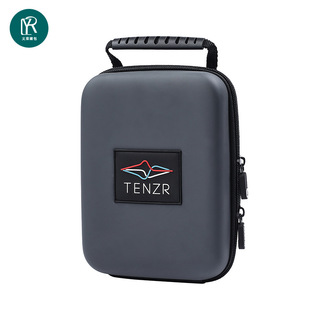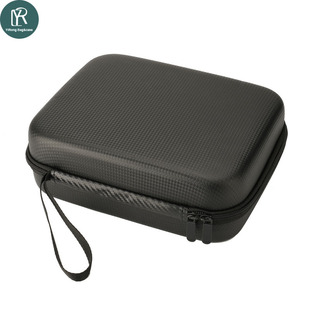A Professional Buying Guide for EVA Tool Bags in Different Industries
In the global tool storage and equipment protection market, EVA tool bags, thanks to their lightweight, durable, and highly customizable features, have become a popular choice for wholesale purchases across various industries. However, the functional requirements for tool bags vary significantly across industries such as electronics, medical, industrial, and outdoor. Misselecting the right tool bag not only increases procurement costs but can also lead to hidden costs such as equipment damage and reduced efficiency. This article will examine the key considerations for selecting EVA tool bags in various sectors, focusing on the fundamentals of industry needs and providing a practical decision-making framework for global professional wholesale buyers.
I. Electronics Industry: Focusing on “Protection + Anti-static” and Controlling Detailed Parameters
For the electronics industry, the core objective of purchasing EVA tool bags is to protect delicate components (such as chips, sensors, and circuit boards) from static electricity, impact, and dust, while also ensuring efficient bulk storage. When purchasing wholesale, pay special attention to the following aspects:
1. Anti-static Performance: Comply with international certification standards
Material Specifications: Prefer EVA substrates with anti-static agents. The surface resistivity must reach 10⁶-10⁹Ω (compliant with ANSI/ESD S20.20 or IEC 61340) to prevent static electricity from damaging components. Suppliers can be requested to provide third-party testing reports to ensure consistent performance across batches.
Structural Design: Conductive foam or anti-static non-woven fabric is recommended for internal compartments, avoiding standard synthetic fabrics. Zippers should be metal anti-static to reduce the risk of frictional charging.
2. Cushioning and Protection: Matching Component Vulnerabilities
EVA Density Selection: Lightweight components (such as connectors and resistors) should use 45-50D density EVA, balancing lightness and basic cushioning. Heavy precision equipment (such as test instruments and module components) should use 60-70D high-density EVA, or a double-layer structure of “EVA + Pearl Foam.” Drop tests must ensure no damage from a height of 1.2 meters.
Customized Grooves: Require suppliers to create custom internal grooves based on component dimensions, with clearances within 0.5-1mm to prevent vibration and collision during transportation. Grooved edges should be rounded to prevent scratches on component pins.
3. Practical Details: Suitable for Bulk Storage and Turnover
Stacking Stability: The exterior design should be flat, and anti-slip grooves can be added to the top to prevent tipping during stacking (recommended stacking height ≥ 5 layers without deformation).
Labeling Compatibility: Labeling space or support for silk-screen QR codes facilitates quick identification of items (such as model, batch, and expiration date) during batch management.
II. Medical Industry: “Sterility + Compliance” as the bottom line, balancing ease of use and safety
In the medical industry, EVA tool bags are primarily used for storing instruments (such as surgical tools, nursing equipment, and testing consumables). They must meet global medical-grade certification standards and meet the requirements for efficient access and cleanliness in healthcare settings. When purchasing wholesale, focus on compliance and suitability:
1. Material Compliance: Avoiding Biocompatibility Risks
Certifications: EVA materials must be certified for biocompatibility by the FDA (US), CE (EU), or ISO 10993. Substrates containing harmful additives such as phthalates and heavy metals are prohibited to prevent chemical migration when in contact with medical devices.
Cleanability: The surface must be treated with a water-repellent and stain-resistant treatment (such as a PU coating), withstand 75% alcohol disinfection, and show no cracking or discoloration after repeated disinfection (a test of ≥500 wipes with no noticeable damage is required).
2. Structural Safety: Prevent Cross-Contamination and Instrument Damage
Zoning and Isolation: Independent compartments should be designed within the “Clean Area – Semi-Clean Area – Contaminated Area” system. Use antimicrobial non-woven fabric (antimicrobial rate ≥ 99%, in compliance with JIS Z 2801) to prevent cross-contamination of instruments.
Securing Method: Surgical instrument kits are recommended to be secured with elastic bandages or Velcro. The tightness should be moderate (ensure instruments remain stable even at a 45° tilt) and facilitate quick removal.
3. Compliance Documentation: Meet Cross-Border Customs Clearance and Traceability Requirements
Suppliers are required to provide complete “Medical-Grade Material Certificates,” “Sterility Test Reports” (if required), and batch traceability tables (including raw material sources, production time, and quality control personnel) to avoid delays in cross-border customs clearance due to compliance issues.
III. Industrial Industry: “Durability + Load-Bearing” as the Foundation, Suitable for Harsh Working Environments
EVA tool bags used in industrial fields (such as machinery maintenance, automotive manufacturing, and construction) must withstand frequent use, heavy objects, and harsh environments (such as oil, dust, and high and low temperatures). When purchasing wholesale, consider durability and functionality as key screening criteria:
1. Material Durability: Resistant to High-Frequency Wear
Exterior Protection: Utilizes a 1680D Oxford cloth + EVA composite structure, with a wear resistance of ≥ 5000 cycles (Martindale Abrasion Test) and resistance to chemical immersion such as motor oil and cutting fluids (no penetration for 24 hours);
Corner Reinforcement: Nylon webbing or metal rivets are sewn onto high-wear areas (such as handles, bottom, and zipper openings). Handles must withstand a load of ≥ 30kg (no breakage after hanging for 48 hours).
2. Load-bearing and Storage: Matching the Characteristics of Industrial Tools
EVA Thickness: Small tools (such as wrenches and screwdrivers) can use 5-8mm thick EVA; large tools (such as electric drills and wrench sets) should use 10-15mm thick EVA. Rubber non-slip pads can be added to the bottom to prevent the tool bag from sliding on oily floors.
Expandable Design: It is recommended to choose a model with side pockets or expansion layers for convenient storage of accessories (such as screws and gaskets). The expansion layer zipper should be waterproof to prevent dust from entering.
3. Environmental Adaptability: Withstands Extreme Working Conditions
High and Low Temperature Performance: The EVA material should not harden, crack, or soften or deform at temperatures between -30°C (low-temperature storage) and 60°C (high-temperature workshop environment).
Waterproof Rating: Must meet IPX4 (splashproof) rating, ensuring that the tools inside will not be damaged by water after being splashed by rain.
IV. Outdoor Industry: “Lightweight + Multifunctional” as the Core, Balancing Portability and Protection
EVA tool bags for the outdoor industry (such as camping equipment, adventure tools, and sports equipment) must balance lightweight portability with outdoor environmental protection, meeting the needs of multiple scenarios. When purchasing wholesale, focus on portability, versatility, and environmental resistance:
1. Lightweight Design: Reduce Carrying Burden
Lightweight Material: Use 38-45D low-density EVA, with an overall weight of 200-500g (depending on size) and a tensile strength of 10MPa or higher to prevent breakage due to lightweight design.
Compact Structure: Foldable or compressible designs are preferred, reducing volume by at least 50% when folded, making it easier to fit into a backpack or storage bag.
2. Versatile Adaptability: Meets Outdoor Needs
Multi-Purpose Compartments: The internal compartments are flexibly removable and adjustable, suitable for storing both camping tools (such as flashlights and multi-purpose knives) and sports equipment (such as cycling gear and fishing accessories).
Additional Features: External hooks (compatible with carabiners), reflective strips (for nighttime safety), and a pre-installed water bottle strap enhance convenience during outdoor use.
3. Outdoor Protection: Resilience: Waterproof: The outer layer must be PVC-coated or TPU-composite fabric with an IPX5 waterproof rating (water jet resistance). An internal waterproof pouch can be added to keep tools dry in heavy rain.
Weather Resistance: The bag must pass UV weathering testing (no fading or cracking after 72 hours of exposure) to prevent material degradation after prolonged outdoor use.
V. Additional Considerations for Buyers: From “Product Selection” to “Supply Chain Optimization”
In addition to industry-specific purchasing considerations, global wholesale buyers must also screen suppliers based on “cost control,” “supply chain stability,” and “customized services” to maximize procurement efficiency:
1. Mass Customization Capabilities: Reduce Procurement Costs
Confirm whether the supplier supports “small trial orders + large-volume production” (e.g., a trial order of 50-100 pieces with a minimum order quantity of 1,000 pieces for large quantities) to avoid inventory backlogs caused by excessively high minimum orders.
Customization Cycle: From design confirmation to mass delivery, the timeframe should be within 15-20 days (excluding logistics time) to ensure rapid response to market demand.
2. Cross-border Supply Chain Support: Addressing Logistics and After-Sales Pain Points
Logistics Partnerships: Prioritize suppliers with long-standing partnerships with international logistics providers such as DHL and FedEx. These suppliers can enjoy bulk logistics discounts (reducing logistics costs by 10%-15%) and provide customs clearance documents (such as commercial invoices, packing lists, and certificates of origin).
After-Sales Guarantee: Require a “free reissue for quality issues” service (e.g., full reissue if the defective rate of bulk products is ≥3%) and support returns and exchanges within 30 days (for trial orders).
3. Case Verification: Reference Industry Customer Feedback
Suppliers are required to provide bulk purchase examples from the same industry (e.g., customizing 10,000 anti-static tool kits for an electronics manufacturer or 5,000 folding tool kits for an outdoor brand). They should also provide customer contact information for word-of-mouth verification to mitigate procurement risks.
Conclusion: Accurately Match Industry Needs to Maximize Purchasing Value
Selecting an EVA tool kit isn’t a one-size-fits-all approach. Instead, it’s crucial to analyze core requirements based on industry specificities. Anti-static protection in the electronics industry, regulatory compliance in the medical industry, durability in the industrial industry, and lightweighting in the outdoor industry are all key considerations in purchasing decisions.
Post time: Oct-22-2025





